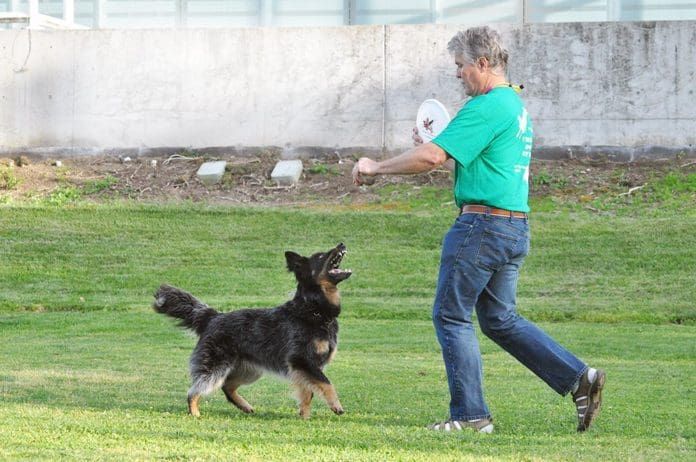Teaching our dogs to look at us is important for training; if we have their attention, we can get them to work with us. If we can keep their attention, we can keep them working with us even in the face of distractions. These things are big accomplishments, but the value of teaching eye contact is even bigger!
I have done behavioral assessments on thousands of shelter dogs over the years. I’ve adopted a few of them, fostered several more, and helped find forever homes for many. Even after decades of shelter work, I am still touched to my soul by the dog who walks up to me, looks me squarely in the eyes, and sends me the powerful, electric message, “I know how to communicate with you.” That’s what teaching eye contact does for our dogs: it opens the door for interspecies communication.
It’s really not natural for dogs to offer direct and prolonged eye contact. In the dog world, direct eye contact is a threat, and the appropriate response to a direct stare is to look away as a deference or appeasement behavior (“I’m not challenging you/please don’t hurt me!”). In many human cultures, however, direct eye contact is considered polite – it means the other is focused and attentive – and it has certainly come to mean that in the dog training world. Like so many other behaviors we expect of our dogs that are alien to their own basic natures, we’ve come to expect our dogs to look at us when we ask them to, and to maintain eye contact for extended periods of time in a variety of contexts.
Eye Exercises
Because eye contact is important for training purposes, we teach eye contact exercises in our classes at Peaceable Paws. Here are some of the exercises that we practice in our basic classes:
Capturing Eye Contact – When dogs come to class for the first time, they are understandably distracted. Rather than letting our students beg and plead for their dogs’ attention, we tell them to sit in a chair and wait. The instant their dog looks at them or even glances in their general direction, they click their clickers and feed their dogs a treat.
You can do the same with your dog. Practice at home first, in the least distracting environment, then when he’s ready, take him out in public. Sit on a chair with your dog in front of you, leashed if necessary, and wait. The instant he looks at you, or near you, click (or use your verbal marker) and feed a high-value treat. You’re reinforcing offered attention – teaching your dog that if he chooses to look at you, he can make you click.
Over time, “shape” for longer eye contact (reward increasingly longer moments of eye contact), and then for eye contact when you’re walking. When your dog is doing well with it, take him out in public and practice there – in a park, on a bench outside your neighborhood pet supply store, in front of the post office, in the lobby of your veterinary clinic . . . the possibilities are endless.
Name Game – If your dog is not offering attention, you can always ask for it – if you’ve taught him that his name means “Look at me for something wonderful!” This is just like “charging” the clicker: say his name, and then feed him a tasty treat when he looks at you. Repeat this game regularly, until your dog instantly swivels his head toward you at the sound of his name. Then practice with increasing levels of distraction. Now you can get his attention if he doesn’t offer it.
Zen Attention – Getting attention is one thing; keeping it is sometimes an entirely different matter. This exercise makes it clear to your dog that eye contact gets reinforced (not just looking at the treat), and allows you to shape for duration. With your dog sitting in front of you, hold a treat straight out at arm’s length to the side. He will likely watch the treat. Just wait.
Here’s the Zen part. In order to get the treat he has to look away from it – back at you. The instant he looks at you (as if to say, “Hey, what’s the deal here?”) you click and feed him the treat. Then do it again. Most dogs figure this out amazingly quickly. When he comprehends that looking at you – not the treat – gets the click (and treat), you can add your “Watch me” cue, and start shaping for eye contact of longer duration.
Me, Not That – Now it’s distraction time. With your “Watch me” cue solidly installed, ask a family member or friend to walk past while you’re reinforcing your dog for looking at you. Use a high rate of reinforcement at first (click and treat a lot) – then decrease the frequency as your dog figures out the game.
If he looks away, use his name or your “Watch me” cue to get his attention back. Click and treat! Gradually increase the intensity of the distraction: Start walking with your own dog toward your human distraction, have your friend whistle, clap his hands or jingle car keys while walking past, then jog, then bounce a ball … get creative!
Take it on the Road – When he’s doing well with his eye contact games, take him out in public and practice there – in a park, on a bench outside your neighborhood pet supply store, in front of the post office, in the lobby of your veterinary clinic . . . the possibilities are endless. With each successful session under your belt, you can plan for a more distracting venue the next time.
Windows to the Soul

If we pay attention to teaching eye contact only for training purposes, we are missing out on one of the most fulfilling aspects of the behavior: our dog’s ability to use his eyes to communicate with us. As behavior science continues to explore and acknowledge the cognitive capabilities of our canine companions, we are realizing that our dogs may possess “theory of mind.”
Theory of mind (often abbreviated ToM) is the ability to attribute mental states – beliefs, intents, desires, pretending, knowledge, etc. – to oneself and others, and to understand that others have beliefs, desires, intentions, and perspectives that are different from one’s own. It is sometimes expressed in “levels” like this:
Level 1 – I know.
Level 2 – I know you know.
Level 3 – I know you know I know.
And on and on…
Although science may not be ready to conclusively grant ToM to dogs, it’s hard to argue that they can’t attain at least Level 1, probably Level 2, and possibly Level 3. When our Kelpie, Kai, sees us packing his training bag and gets all excited, it seems like a clear indication that he knows he’s going to agility class. When he dances happily in front of us, making strong direct eye contact, one might suggest he’s saying, “I know you know we’re going to agility class.” And when he runs to the door and looks purposefully back at us, one could hypothesize that he’s saying, “I know you know I know we’re going to agility class!”
This isn’t just an academic exercise. Humans who have close relationships with their dogs recognize ToM communications in their daily interactions with their canine family members – and it often involves eye contact:
Bonnie, our Scotti/Corgi/Poodle-mix, comes and sits next to me as I type on my computer, looking intently into my eyes. “Oh,” I realize. “She has to go out.”
As we walk toward the back door, Lucy, our Cardigan Welsh Corgi, runs ahead of us, stops in front of the bookcase, looks at me, looks at the top shelf of the bookcase, and looks toward the door. “Oh,” I realize. “She wants me to take her out and throw the Frisbee that is sitting on top of the bookcase.”
I’m assessing a dog at the shelter who looks somewhat stressed and shut down. I say “Sit!” and his eyes light with joy as he plops his bottom to the ground and looks into my eyes as if to say, “Finally! Someone who knows what I know!”
You may have your own examples of this kind of cognitive communication with your dog. To nurture this thrilling connection, pay even closer attention to your dog’s efforts to communicate with you. When he makes eye contact, contemplate what he’s trying to tell you and respond appropriately. By reinforcing his eye-contact communications you will encourage him to communicate more, and you’ll get better and better at translating his messages.
When dogs learn the value of communicating through eye contact, it opens up a whole new door in the relationship between the two of you, and makes your time together even more rewarding and satisfying for you both.
Pat Miller, CBCC-KA, CPDT-KA, is WDJ‘s Training Editor. She lives in Fairplay, Maryland, site of her Peaceable Paws training center, where she offers dog-training classes and courses for trainers. Miller is also the author of many books on positive training. Her two most recent books are Do Over Dogs: Give Your Dog a Second Chance at a First-Class Life, and How to Foster Dogs; From Homeless to Homeward Bound.







My labradoodle barks anytime some goes by the house, at bicycles and runners when out walking, not to mention the squirrels. He is 5 and loves me more than anything. How can I address the barking.